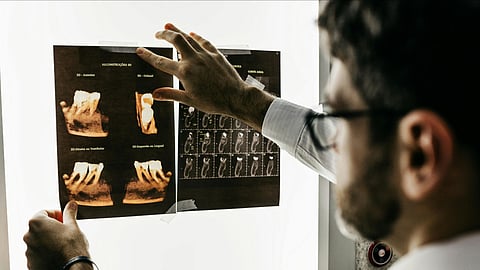Challenges and Limitations
Several hurdles remain before these innovations become practical:
The current results are derived from mouse cells, and human odontogenesis is more complex.
Lab-grown teeth lack blood vessels and neural networks for real-life function.
The regenerated tooth structure is in its initial developmental stages and may have incomplete structural maturity.
The hydrogel’s biocompatibility, degradation rate, and immune response in human tissue are not fully understood. The unknown scaffold behavior of the matrix in humans should be addressed.
Implanting and aligning lab-grown teeth within the jawbone remains technically challenging.
The Future of Regenerative Dentistry
Clinical Applications and Next Steps
Dr. Xuechen Zhang explained that the next step is to determine how to translate lab success to real patients. Two main options are being explored:
Transplanting immature tooth cells into the jaw and allowing them to grow in place
Growing complete teeth in the lab, then implanting them into patients
Both approaches require starting the earliest stages of tooth formation in the lab.
Advancing Customized Dental Care
This technique leads to customized dental care using a patient’s cells, enabling biologically matched tooth regeneration (2) that is:
Similar Global Studies
GelMA-Based Bioengineered Tooth Bud (2018, Tufts University School of Dental Medicine, Boston)
Developed tooth bud models using gelatin methacryloyl (GelMA) hydrogels, seeded with dental stem cells and later implanted in pigs. Tooth-like structures, including dentin-pulp complexes, were formed.
Injectable Microcarrier-Hydrogel Composites for Dental Stem Cells (2023, National University of Singapore)
Demonstrated that injectable hydrogel composites assist in the delivery and differentiation of dental pulp stem cells (DPSCs) for pulp regeneration.
PLGA Hydrogel Scaffolds with Dental Pulp Stem Cells (2024, University of Medical Science, Tehran, Iran)
Showed that PLGA scaffolds enhance the regenerative capacity of human DPSCs for dental tissue formation.
3D-Printed HA/PLA Scaffolds in Canine Models (2021, Tufts University School of Dental Medicine, Boston)
Used hydroxyapatite/poly (lactic acid) scaffolds in dogs, demonstrating enhanced mineralization and early dental tissue regeneration.
Hydrogel-Loaded Dental Stem Cells for Tissue Regeneration (Review)
Reviewed various hydrogels combined with dental stem cells for regenerating both soft and hard dental tissue.
Tooth Regrowth Therapy Trials for TRG-035 (2024, Kitano Hospital and Kyoto University Hospital)
Initiated the first human clinical trials for TRG-035, a drug targeting the USAG-1 protein that suppresses natural tooth development.
Expert Opinions


